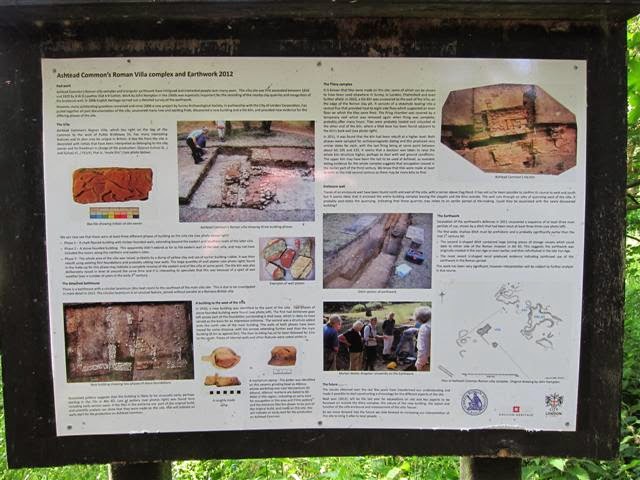Adjacent to my regular patch circuit around Epsom Common Ponds is Ashtead Common National Nature Reserve, extending over 500 acres of ancient woodland owned and managed by the City of London Corporation. In the 1870's the City was concerned that access to the open countryside was being threatened, and as a result promoted two Acts of Parliament to enable it to acquire and protect various open spaces from development.
Last month during a walk with one of the Wardens I offered my services to carry out Butterfly recording over a new fixed route (transect) starting in April 2015. I have walked the proposed route on several occasions recently and this post provides an insight to the varied wildlife I have already encountered.
The start of the transect begins at 'Chessington View' overlooking the fields above Rushett Farm, a good spot to listen to Skylarks in the Spring and to locate Nuthatch at almost any time of the year. During the winter large flocks of Redwing and Fieldfare congregate in the trees in between their feeding forays onto the nearby fields. Carrion Crows, Jackdaws and Magpies are fairly numerous throughout most of the year.
[Eurasian] Nuthatch. (Sitta europaea)
The route climbs gently upwards following one of the main rides through the woodland passing an area that was cleared some time ago and the coppiced Hazel was protected by woven rustic barriers to prevent it being browsed by Deer and it appears to have been sucessful.
This 1st section has already produced recent sightings of Brimstone, Green-veined White, Speckled Wood, Meadow Brown, Comma and Silver-washed Fritillary. Bird species seen or heard here include Great-spotted Woodpecker, Robin,
Blackbird, Song Thrush, Blackcap, Chiffchaff, Chaffinch, Treecreeper,
Blue, Great and Long Tailed Tits, Goldcrest and the very noisy
Ring-necked Parakeets.
Speckled Wood.
Section 2 is over similar terrain and passes a very muddy coloured pool called Flag Pond where all three species of Newt; Common, Palmate and Great crested have been recorded.
This is a good place to search for Dragonflies and Damselflies.
Ruddy Darter. (Sympetrum sanguineum)
There are over 2,300 ancient pollarded Oaks across the common which play
host to an amazing variety of wildlife; bugs, insects and nesting opportunities for many species of birds. A year ago I noticed that some
of the Birch trees had been 'ring-barked' which prevents the sap flowing
upwards and now a few have felled themselves ... just one of the many
simple and natural methods employed in managing the woodlands.
The woodlands can often be surprisingly quiet until the peace is shattered by the very distinctive loud burst of song from one of the many resident Wrens.
A juvenile Wren. (Troglodytes troglodytes)

My route then passes around an area of archeological significance, the site of a 1st and 2nd Century AD Roman Villa, Bath House with adjacent tile works.
The open area below the 'King Oak' should be a very good spot for butterfly species. I have already logged Meadow Brown,
Ringlet, Gatekeeper, Small and Large
Skippers, Comma and Peacock. This part of the common with its mix of Oaks and Sallows is also an excellent place to see Purple Hairstreak and the handsome Purple Emperor.

As my boots brushed past the grasses lining the narrow path numerous Grasshoppers of different sizes and colours hopped from stem to stem.
I don't know if this is typical but every time the lens got close they all tried to move around the grass stem to hide!
A young Roe Deer patiently watched my progress before heading off into the undergrowth.
There are a number of seats along my route providing convenient spots to rest awhile and watch the wildlife.
Sometime I find someone has also used it for other purposes ... the remains of a recent Hazelnut snack by a Grey Squirrel.
At the end of section 6 close to my rest stop I spotted a
Hornet and a resting
Migrant Hawker.
Various gates and fences are encountered all over the common and many of the latter form the boundaries to specific areas that are grazed by cattle on a rotation basis to maintain this special landscape.
Some of the main open rides are designated bridleways but access to
many other pathways is restricted by the use of natural Birch filled
barriers that need to be regularly topped up during the year.
Silver-washed Fritillary.
The final two sections of the transect follow part of the north-western boundary overlooking Rushett Farm where it is not uncommon for me to find a Common Buzzard, which nest in the adjacent wood, perched on one of the old Oaks or soaring above the fields.
If all goes well with the arrangements for next year I'll look forward to providing weekly wildlife updates between April and September from this interesting location.
FAB.
I'm linking this post to:
Saturday's Critters hosted by Eileen
Camera Critters hosted by Misty
I'D-Rather-B-Birdin' hosted by Anni












